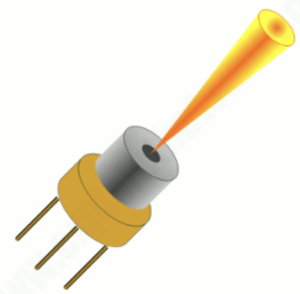Laser diodes are compact semiconductor devices that generate coherent light through stimulated emission, revolutionizing industries from telecommunications to healthcare. Unlike traditional lasers (e.g., gas or solid-state), laser diodes excel in efficiency, size, and versatility, making them indispensable in modern technology.
Table of Contents
ToggleHistorical Background
- 1962: Robert N. Hall creates the first semiconductor laser diode using gallium arsenide (GaAs), operating in pulsed mode at cryogenic temperatures.
- 1970: Continuous-wave (CW) operation at room temperature is achieved, enabling practical applications.
- 1990s: Breakthroughs in blue and green lasers via gallium nitride (GaN) by Shuji Nakamura, Isamu Akasaki, and Hiroshi Amano (Nobel Prize in Physics, 2014).
- 2000s–Present: Advancements in vertical-cavity surface-emitting lasers (VCSELs) and quantum cascade lasers (QCLs) expand applications in sensing and data communication.
Working Principle
1. Structure
- PN Junction: A PIN structure with an intrinsic (undoped) active region sandwiched between p-type and n-type semiconductors.
- Materials: Vary by wavelength (e.g., GaAs for IR, InGaN for blue/green).
- Optical Cavity: Facets at each end act as mirrors; one facet is partially reflective to emit light.
2. Key Processes
- Current Injection: Electrons and holes recombine in the active region, emitting photons.
- Population Inversion: Achieved when more electrons occupy higher energy states than lower ones.
- Stimulated Emission: Photons stimulate further emissions, creating coherent, monochromatic light.
- Optical Feedback: Photons reflect within the cavity, amplifying light until it exits as a laser beam.
Types of Laser Diodes
- Edge-Emitting Lasers (EELs)
- Structure: Light emits from the edge of the chip.
- Uses: Fiber optics, industrial cutting.
- Subtypes: Fabry-Pérot (FP), Distributed Feedback (DFB), and Distributed Bragg Reflector (DBR) lasers.
- Vertical-Cavity Surface-Emitting Lasers (VCSELs)
- Structure: Light emits perpendicular to the surface.
- Advantages: Low divergence, high modulation speed.
- Uses: Optical mice, facial recognition (e.g., smartphone Face ID).
- Quantum Cascade Lasers (QCLs)
- Mechanism: Uses intersubband transitions in quantum wells for mid-IR to terahertz wavelengths.
- Applications: Environmental monitoring, medical diagnostics.
- Tunable Laser Diodes
- Feature: Wavelength adjustable via temperature, current, or external cavities.
- Uses: Spectroscopy, dense wavelength-division multiplexing (DWDM).
Applications
- Telecommunications: Fiber-optic data transmission (DFB lasers for single-mode efficiency).
- Consumer Electronics: Blu-ray players, laser printers, barcode scanners.
- Medical: Surgical tools, dermatology, photodynamic therapy.
- Industrial: Precision cutting, welding, 3D printing.
- Automotive: LiDAR for autonomous vehicles, collision avoidance.
- Sensing: Gas detection, environmental monitoring (QCLs), biometrics.
Advantages and Challenges
Advantages
- High Efficiency: 30–70% electrical-to-optical conversion.
- Compact Size: Millimeters in scale, ideal for portable devices.
- Modulation Speed: GHz-range for high-speed data transfer.
- Long Lifespan: Up to 100,000 hours under optimal conditions.
Challenges
- Thermal Management: Requires heat sinks or thermoelectric coolers to prevent efficiency drop.
- Beam Divergence: Needs collimation optics for focused applications.
- Sensitivity: Static electricity and current spikes can damage junctions.
Future Trends
- Quantum Dot Lasers: Enhanced temperature stability and wavelength flexibility.
- Silicon Photonics: Integration with silicon chips for faster data centers.
- High-Power Diodes: Advances in cooling and material science for industrial uses.
- Biophotonics: Non-invasive medical imaging and therapies.
- Plasmonic Lasers: Subwavelength light confinement for nanoscale applications.
Conclusion
Laser diodes are pivotal in modern technology, continually evolving to meet demands in communication, healthcare, and beyond. With ongoing research in materials and integration, their role in emerging fields like quantum computing and autonomous systems is set to expand, underscoring their enduring significance.
4.8/5 - (26 votes)
I am Jody, your trusted IC chips supplier with extensive experience in providing high-quality, reliable, and innovative semiconductor solutions. Committed to excellence, I specialize in delivering authentic components, competitive pricing, and exceptional customer service to meet the needs of manufacturers, engineers, and businesses worldwide. Partner with me for your electronic component needs.
Latest posts by Jody (see all)
- Everything You Need To Know About Limit Switch - May 21, 2025
- Everthing You Should Know About Rheostat - May 20, 2025
- Everything You Need To Know About Reversing Contactor - May 19, 2025







